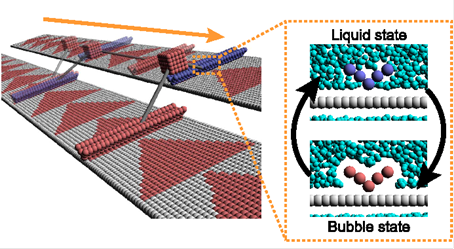March 2014 Issue
Research Highlights
Molecular motors: Bubble-driven walking
Computer simulations of relatively simple models provide clues to the complex physical mechanisms at work in real biomolecule motors.
The asymmetric Brownian ratchet model describes a motor particle moving on a rail (for example a protein like kinesin walking a on a microtubule). There are two possible states: in one the particle moves in a random walk along the rail; in the other it feels the asymmetric potential from the rail. Alternating between these two states leads to a directed movement.
A collaboration including the University of Electro-Communications, Keio University, RIKEN, University of Fukui and University of Nebraska-Lincoln led by Noriyoshi Arai previously suggested that the transition between the two states is caused by bubble formation. Arai and co-workers have now refined their model including a more realistic temperature-controlled switching mechanism.
In their model the two states of the asymmetric Brownian ratchet are a hydrophobic 'bubble state' and a hydrophilic 'liquid state'. In the former, the motor is close to the rail, bubbles form due to the hydrophobic effect and the motor feels an asymmetric potential. In the latter, the motor is far from the rail and due to thermal fluctuations it moves randomly along it. The switching between the two states is caused by the change of hydrophobic/hydrophilic parameter of the motor controlled by the temperature of the motor itself.
As computer simulations indicate, the mechanism proposed by Arai and collaborators could lead to very efficient walking depending on the material used for the motor, for example thermosensitive polymers.
Publication and Affiliation
Noriyoshi Arai*1,2,3, Kenji Yasuoka2,Takahiro Koishi4, Toshikazu Ebisuzaki3, and Xiao Cheng Zeng5. Understanding Molecular Motor Walking along a Microtubule: A Themosensitive Asymmetric Brownian Motor Driven by Bubble Formation. J. Am. Chem. Soc. 135, 8616−8624, (2013).
- Department of Mechanical Engineering and Intelligent Systems, University of Electro-Communications, Chofu, Tokyo, Japan
- Department of Mechanical Engineering, Keio University, Yokohama, Japan
- Computational Astrophysics Laboratory, RIKEN, Wako, Saitama, Japan
- Department of Applied Physics, University of Fukui, Fukui, Japan
- Department of Chemistry, University of Nebraska-Lincoln, Lincoln, Nebraska, United States
*Corresponding Author:



